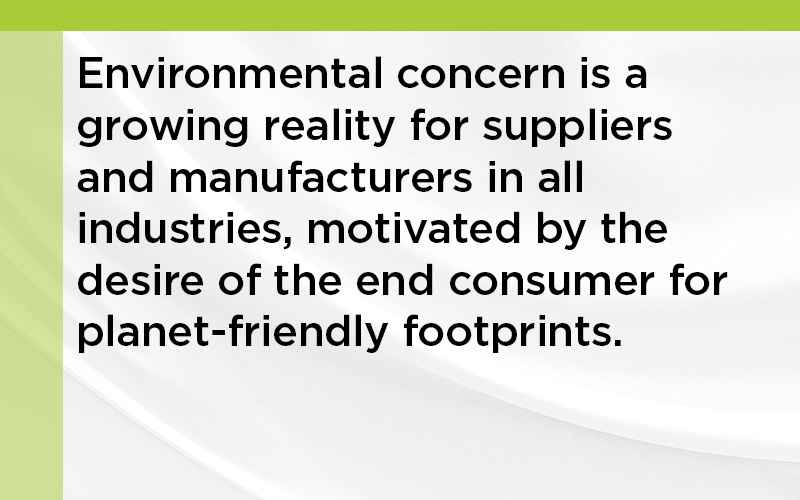
by: Dianna Brodine
Concern grows daily over the state of our natural resources and the impact is being felt in the printing industry. Driven by consumer desire for products that are “green,” companies are taking action to utilize forest and water resources in a responsible manner. The Forest Stewardship Council (FSC) advocates for sustainable forestry and is leading the environmental charge for green printing practices.
The Forest Stewardship Council
The FSC was created in 1993 in response to a worldwide need to preserve forestry resources, while at the same time meeting commercial product needs. Comprised of loggers, foresters, environmentalists, and sociologists, the FSC created standards for forest management that are now accepted in more than 55 countries.
There are two certifications issued by the FSC that apply to the printing industry. The first is FSC certification, which indicates that strict forest management standards were followed in harvesting trees for use in commercial applications. There are 10 principles, ranging from compliance with the laws of the country in which the harvesting takes place to respect for the rights of indigenous people and workers to minimizing environmental impact. FSC certification for the forestry source is the initial step for print industry members who want to be “green”.
Any product made of pulp or paper has the potential to be certified as long as the wood used in the product originates from FSC-certified sources. Wood is an important material for all paper manufacturers. The FSC certification system allows these professionals to know they are doing the right thing and taking business away from other companies that may still be supporting illegal, unsustainable, unverified logging activities. (FSC web site, www.fscus.org)
The second standard is Chain-of-Custody (COC) certification. COC states that the raw materials harvested from an FSC-certified source have been processed, manufactured, distributed, and printed through sources that also have achieved COC certification.
Again, to assure the credibility of claims on products, it is important to track materials as they leave the forest and become products down stream. This “chain of custody” (COC) certification process is quite simple. Like any inventory control system, COC allows products to be segregated and identified as having come from a particular source – in this case, an FSC-certified forest. FSCs model of certification allows products that flow from certified forests to enter the marketplace with a credential that is unique. (FSC web site, www.fscus.org)
Applying Green to the Marketplace
Gane Brothers and Lane, a 160-year-old materials provider in Elk Grove Village, Ill., is working with FSC Chain-of-Custody certified vendors to make sure the printing, binding, and loose leaf industries have access to “green” cover board and papers.
Jeff Carlson, vice president of marketing for Gane, confirmed that the trend toward green materials is motivated by the end consumer. “We are getting more requests for information via e-mail and phone, asking about FSC-certified materials. The people that are contacting us are the manufacturers and their questions are being driven by customers who have a particular interest in the green movement.”
Gane was fortunate in that it didn’t have to search out new providers of FSC-certified materials. Gane has been working with FiberMark and Eska Graphic Board for a few years and the companies have carton stock and board product that has achieved certification.
Since many of the consumable items labeled as “green” reach retail shelves at a higher price point than similar non-green items, it would be reasonable to assume that green printing materials would also have a higher cost. According to Carlson, that assumption is incorrect. “I don’t see any discernible difference in pricing between these materials and materials that are not certified.”
Paper products that are FSC-certified have the same physical characteristics and attributes as non-certified products, with no compromises in quality. “Compared to other board products that are used for the same purpose, the certified board is almost identical,” stated Carlson. “There’s no difference in performance.”
The movement toward green printing is just beginning and Carlson acknowledges that offering FSC-certified products gives the supplier an edge, but that’s not the only reason for Gane to offer environmentally friendly materials. “Obviously, a lot of people are looking into green products,” Carlson said. “To be able to offer those makes us a more valuable supplier, but we try to do our part, too. As a company, we recycle because we’re concerned about the environment as well.”
Environmental concern is a growing reality for suppliers and manufacturers in all industries, motivated by the desire of the end consumer for planet-friendly footprints. The Forest Stewardship Council is leading the charge in the print business by providing certifications that ensure responsible use of forestry resources. Material providers like Gane Brothers & Lane are doing their part by making COC-certified materials available to print and bindery customers.

